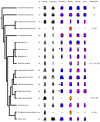Evolutionary Dynamics of the W Chromosome in Caenophidian Snakes
- PMID: 29283388
- PMCID: PMC5793158
- DOI: 10.3390/genes9010005
Evolutionary Dynamics of the W Chromosome in Caenophidian Snakes
Abstract
The caenophidian (assigned also as "advanced") snakes are traditionally viewed as a group of reptiles with a limited karyotypic variation and stable ZZ/ZW sex chromosomes. The W chromosomes of the caenophidian snakes are heterochromatic, and pioneering studies demonstrated that they are rich in repetitive elements. However, a comparative study of the evolutionary dynamics of the repetitive content of the W chromosome across the whole lineage is missing. Using molecular-cytogenetic techniques, we explored the distribution of four repetitive motifs (microsatellites GATA, GACA, AG and telomeric-like sequences), which are frequently accumulated in differentiated sex chromosomes in vertebrates, in the genomes of 13 species of the caenophidian snakes covering a wide phylogenetic spectrum of the lineage. The results demonstrate a striking variability in the morphology and the repetitive content of the W chromosomes even between closely-related species, which is in contrast to the homology and long-term stability of the gene content of the caenophidian Z chromosome. We uncovered that the tested microsatellite motifs are accumulated on the degenerated, heterochromatic W chromosomes in all tested species of the caenophidian snakes with the exception of the Javan file snake representing a basal clade. On the other hand, the presence of the accumulation of the telomeric-like sequences on the caenophidian W chromosome is evolutionary much less stable. Moreover, we demonstrated that large accumulations of telomeric-like motifs on the W chromosome contribute to sexual differences in the number of copies of the telomeric and telomeric-like repeats estimated by quantitative PCR, which might be confusing and incorrectly interpreted as sexual differences in telomere length.
Keywords: FISH; GATA; heterochromatin; microsatellites; sex chromosomes; telomeres.
Conflict of interest statement
The authors have no conflicts of interest to declare.
Figures


References
-
- Uetz P., Freed P., Hošek J., editors. The Reptile Database. [(accessed on 6 August 2017)]; Available online: http://www.reptile-database.org.
-
- Olmo E., Signorino G.G. Chromorep: A Reptile Chromosomes Database. [(accessed on 26 August 2017)];2005 Available online: http://chromorep.univpm.it.
LinkOut - more resources
Full Text Sources
Other Literature Sources

